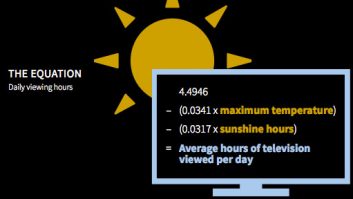
2016 saw a new generation of immersive media technologies come to market. Oculus Rift, HTC’s Vive and Microsoft’s HoloLens were first out the gate, but the mainstream audience is most likely to experience good quality VR on Sony’s more affordable PSVR platform, which struggled to meet consumer demand at year end. Google has also launched its smartphone-centric Daydream VR specification in an attempt to bring entry level VR to a much wider demographic. If momentum is to be maintained in 2017, we need to see great content emerge. Many are still sceptical of the format, and with memories of 3DTV’s demise still fresh, this is understandable. But at CES, and then NAB, immersive media will draw the crowds.
UHD made solid progress in 2016 and as the price and quality of TVs improve in 2017, consumer uptake will start to drive demand for more content. The OTT providers have stolen the lead here, with both Netflix and Amazon releasing flagship content in UHD. The pressure is on the rest of the industry to respond.
The media industry really started to embrace cloud-based services in 2016 and we can expect to see more of the same in 2017. As our technology stack evolves to take advantage of cloud architectures, the public providers are introducing new features that make them more attractive for our use cases. Lower cost and more flexible GPU instances and the introduction of FPGA-backed instances in 2017 will provide much greater performance for demanding media operations. If they can get the economics right, we can start to build very sophisticated and scalable services on top of these platforms.
Next-generation IP
The transition to IP-based transport in studios and broadcast facilities has started to take shape, but the first generation of protocols such as SMPTE 2022:6 are an intermediary step. Encapsulating SDI over IP is useful as a first step, but the industry is already working hard on a native IP implementation based on the work of the VSF, AMWA, SMPTE and others. We can expect to see a great deal of focus on this area in 2017, with organisations such as AIMS bringing together vendors of all sizes with a common vision to transform how we move high bitrate media around professional environments in an interoperable manner.
Software-defined broadcasting
Another major development in 2016 was the transition from hardware-provided products to software provided products. This provides much greater deployment flexibility for those building and managing broadcast systems, but the evolution will continue in 2017. While the current generation of software products are largely based on virtual machine (VM) based implementations, the trends in software engineering are towards container-based models and microservices-based architectures. These are not minor changes, and require significant refactoring of the underlying software design but promise to return even greater levels of flexibility, control and improved software release cycles.
If anything, 2017 seems likely to see more technology evolution and at a faster pace than the year before. The challenge for us all now is to leverage these developments to deliver better business outcomes and better audience experiences in a rapidly changing industry.
By Steve Plunkett, CTO, broadcast and media services, Ericsson







